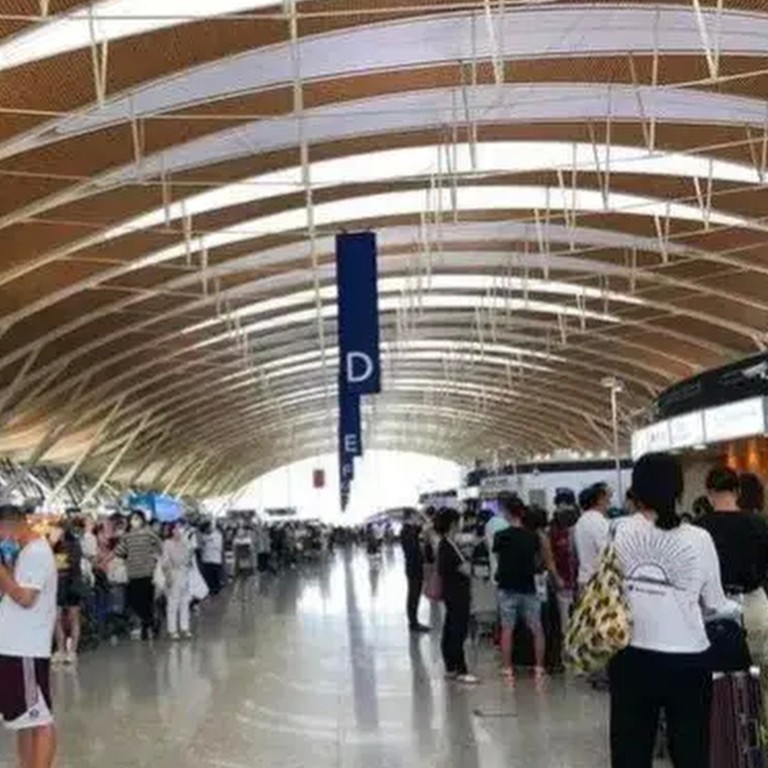
The high price Chinese students pay for university in the US during the Covid-19 pandemic
- Chinese students keen to get an American education amid geopolitical tension and the spread of Delta must make a big investment – and that’s just the airfare
- US-bound students are reported to have a formed a line 1km long at Shanghai as restrictions on the number of flights keep prices high
On Friday, the cheapest one-way ticket from Beijing or Shanghai to New York, Boston or other major US cities with two transfers cost nearly 20,000 yuan (US$3,000) departing on any date before September 1.
Flights with one transfer in Hong Kong cost up to 80,000 yuan, according to booking site Trip.com. The cheapest were at least twice the price of those at the same time of year before the pandemic.
US to limit some Chinese flights to 40 per cent capacity
Andrew Li, who will fly to the east coast of the US early next month for a master’s degree programme, said that when he started to search for tickets in late June, fares were 20,000-30,000 yuan.
“In the end, I bought a single ticket with one transfer in Hong Kong for more than 20,000 yuan. It is the most expensive air ticket I’ve ever bought,” Li said.
The US State Department announced in April that students with valid visas could enter the country 30 days before college started and did not need an individual national interest exception to travel. It came more than a year after the United States suspended entry for people in mainland China 14 days before arriving in the US.
On August 1, the travel ban was further eased. Chinese students no longer had to be quarantined in a third place for two weeks before entering the country.
Chinese students looking abroad are worried, but not about the pandemic
It followed Beijing’s decision to impose similar limits on four United Airlines flights after five passengers on a flight from San Francisco to Shanghai reportedly tested positive for Covid-19 on July 21.
Li said he was determined to go to the US, no matter how expensive or difficult the trip might be.
“It’s a two-year programme and I spent the first year in front of my computer, attending virtual learning sessions in China,” Li said. “I’m longing for the experience of studying in the US.”
Numbering around 372,000, Chinese students accounted for 35 per cent of the international contingent in the US in the 2019-20 school year, according to International Education Exchange (IEE), nearly twice as many as the next biggest group – students from India.
Felix Liu, who will fly to New York next week to attend a postgraduate programme, said he spent over two weeks in May planning the flight.
After comparing more than 15 options, he decided to depart from the southern city of Shenzhen for Hong Kong before flying to New York, transferring in Doha, Qatar. The tickets cost him over 8,000 yuan.
“The prices of over 20,000 yuan are a bit pricey. So I checked airlines’ apps, called the carriers and made a list of options on my whiteboard until I figured out an optimal solution,” he said.
“Using the saved money, my mum bought me hand sanitiser and 1,000 surgical masks,” he said. “She’s so worried about infection caused by the Delta variant, while my biggest concern is whether autumn semester classes will be entirely in-person on campus.”
Why China cracked down on education, upending a US$70 billion industry
US-bound students formed a line about 1km long at check-in counters at Shanghai Pudong Airport on Monday, the Shanghai-based China Business News reported.
The check-in process has been complicated by Covid-19 control paperwork. Passengers flying to the US from China are required to show a negative Covid-19 test taken within 72 hours before departure, an address and contacts at their final destination and a signed statement attesting to their Covid-19 status.
Wu Qing, a public servant in Ningbo in the eastern province of Zhejiang, said it took her daughter nearly five hours to go through all the formalities at the airport in Shanghai on Monday before she boarded the plane to the US.
“The ticket cost us over 20,000 yuan, which is quite a lot of money,” Wu said.
“The bilateral relations are deteriorating and nationalism is on the rise in China. It’s not an easy decision to continue studying in the US. I hope it’s worth the money and the trouble,” she said.
Additional reporting by Coco Feng

